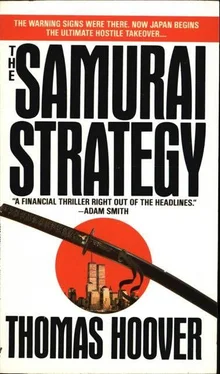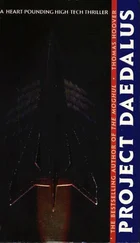Thomas Hoover - The samurai strategy
Здесь есть возможность читать онлайн «Thomas Hoover - The samurai strategy» весь текст электронной книги совершенно бесплатно (целиком полную версию без сокращений). В некоторых случаях можно слушать аудио, скачать через торрент в формате fb2 и присутствует краткое содержание. Жанр: Триллер, на английском языке. Описание произведения, (предисловие) а так же отзывы посетителей доступны на портале библиотеки ЛибКат.
- Название:The samurai strategy
- Автор:
- Жанр:
- Год:неизвестен
- ISBN:нет данных
- Рейтинг книги:5 / 5. Голосов: 1
-
Избранное:Добавить в избранное
- Отзывы:
-
Ваша оценка:
- 100
- 1
- 2
- 3
- 4
- 5
The samurai strategy: краткое содержание, описание и аннотация
Предлагаем к чтению аннотацию, описание, краткое содержание или предисловие (зависит от того, что написал сам автор книги «The samurai strategy»). Если вы не нашли необходимую информацию о книге — напишите в комментариях, мы постараемся отыскать её.
The samurai strategy — читать онлайн бесплатно полную книгу (весь текст) целиком
Ниже представлен текст книги, разбитый по страницам. Система сохранения места последней прочитанной страницы, позволяет с удобством читать онлайн бесплатно книгу «The samurai strategy», без необходимости каждый раз заново искать на чём Вы остановились. Поставьте закладку, и сможете в любой момент перейти на страницу, на которой закончили чтение.
Интервал:
Закладка:
Together with Noda and his bodyguard/chauffeur we were headed for the Electrotechnical Institute, where he was about to give us our first glimpse of Japan's new high-tech empire. That lab just so happened to be the place where heavy work was underway on applications of the artificial intelligence effort of Kenji Asano's Fifth Generation shop. It was merely the first stop, however, in an odyssey Noda claimed would take us through the hidden heart of Japan's industrial future.
Noda reported he had spoken with Kenji Asano, who was unfortunately tied up in meetings and couldn't join us until tomorrow. Thus Tam had not yet had her chance to hear his account of MITI's sudden new interest in Dai Nippon's program. All the same, Noda claimed to welcome Ken's arrival.
"Whatever concerns you may have, I'm sure he will be more than happy to address them," declared the president of Dai Nippon.
Tam had tried on her own to reach Ken at his office, without success. Maybe, I thought to myself, he just didn't want to talk. In any case that quandary remained unresolved.
The way I saw the situation, though, we had enough to deal with merely getting through today. Noda's game was no longer a game. He was going to take us to the top of the mountain, show us the other side, and then… what? Whatever it was, that part would have to be handled in due time. For now his intentions seemed to be to drive home a singular point: if you think Dai Nippon has been playing hardball with money, wait till you see Japan's real action. He was going to lay bare the empire, the awesome machine he now had at his command. The payoff of Tsukuba, he explained, was intended to be nothing less than total technological supremacy.
The limo was slowing to a stop in front of an oddly shaped concrete building, brand-new, that covered several acres with cones and hexagons and various geometries. We'd arrived.
"This is the Electrotechnical Institute, research center for Japan's Advanced Robot Technology Project." He pointed. The laboratory appeared to be somebody's idea of what architecture would be in the twenty-first century, a sort of Japanese spaceship splattered across a vast acreage. "The work underway here and over at the Mechanical Engineering lab is intended to coordinate all government and private research on industrial robots."
He stepped out and motioned for us to join him. Our top- secret tour had begun. As we walked toward the main entryway, he delivered an opening summary.
"Here we have allocated twenty billion yen, about a hundred and fifty million dollars, for an eight-year research program to perfect a range of industrial robots." He continued while we walked past the small gray metallic sign, in both Japanese and English, that identified the Institute. "It is being closely coordinated with the spin-offs of the Fifth Generation AI work."
I noticed that no guards were posted, though the metal doors were tightly sealed. Noda didn't bother to take out a key as he proceeded. "The Advanced Robot Technology Project coordinates the research of over twenty corporations as well as R amp;D at various universities, and this lab is where we integrate all the results of that work."
"You mean different parts or robots are being created at separate research operations, then brought together here?" I probably shouldn't have been surprised by the tight, nationwide coordination. Typical Japan.
"Precisely. Robots have a multiplicity of elements. There are manipulators, the mechanical versions of our hands; then there are the senses of vision and touch; and finally there is movement, locomotion. Each of these is being developed individually, then combined here. For example, if a robot is to understand voice commands-in effect making its operator a programmer-then it must incorporate the speech recognition work of the Fifth Generation Project, which will supply the eyes, the ears, the brain."
Maybe that's where Asano comes in, I thought. Could it be he's the point man here for artificial intelligence, on board to oversee creating the computerized brains for all these babies. Was he yet another DNI operative, witting or unwitting, just as Tam and I had been?
Noda's lecture was still underway. "The first generation of robots does things by rote, the same motion repeated dumbly over and over again. What we call the second generation are those with crude sensing abilities, perhaps touch pads or video, though they are still stationary." He placed his hand over a small screen by the door. A light flashed under his palm-presumably allowing a computer somewhere to analyze his handprint-and a second later the door slid open. Then he continued, "The goal of the work here is a third-generation robot. You might almost call it a functional 'android,' since it will be able to move, see, and think much as we do. Whether it will actually look like a human is another matter, but that's not necessarily even a useful objective."
Intelligent monsters in silicon and steel, I found myself thinking. All our fantasies, or nightmares, come to life.
I didn't have to look far to see that they were already in the womb. We were entering the main laboratory floor now, surrounded by what seemed a Martian landscape of mechanical creatures. The place was bustling, yet spotless as a hospital ward. Noda acknowledged the deep bows of several of the shirt-sleeved staff, then continued.
"Although visitors are not normally permitted in the sensitive areas here, I have arranged total-access priority for you both. I consider you among the few Americans today who can understand the strategic significance of this program."
If Matsuo Noda was really saying that he intended to give us a sobering dose of Japan's impending high-tech clout, he was off to a bang-up start.
Then he turned and greeted a short, white-uniformed man. "Allow me to introduce Dr. Noburu Matsugami, who is senior staff specialist for the program here. Dr. Matsugami will be your guide today."
Matsugami was close to fifty and balding, with short- cropped hair that seemed to stand out on the sides of his head like the bristles of a metal brush. He was bowing to Noda every other second, as though he'd just been summoned by God. He attempted a smile, then greeted us in Japanese, followed by accented English.
I surveyed the floor-steel and aluminum and computers- feeling as if I could have been on another planet. Tam, strangely, had said scarcely a word the whole time. She probably knew about a lot of this, but surely not the proprietary, advanced devices.
Noda's glimpse of Japan's industrial "Manhattan Project" was one of the most memorable experiences of my life. Although I suspect the devices he let Matsugami show us were just the toys, they still were enough to leave no doubt where things were headed.
Without going into the classified details, let me attempt to describe a few of the items I still remember. I was particularly impressed by the Waseda University/Hitachi walking robot WHL-II, which uses advanced machine technology and computer control to move just as a human does, two-legged style. Its hydraulic steel joints and carbon-fiber muscles, together with its computerized foot sensors, give it walking skills better than most young humans'. Its brain of course is a microprocessor, programmed to let it walk in different styles, just as we do. Other mobile robots had four legs, even six-such as the Titan III, which we saw climb up a set of stairs like a metallic sci-fi spider.
As for robot hands, the most advanced also were from Hitachi's mechanical engineering research lab. Unlike most robot grippers, little more than glorified vises, this one had three fingers (which Matsugami claimed were more agile than a version at MIT) whose "muscles" were a heat-sensitive metal (invented in the U.S.) that would contract when an electric current passed through.
Читать дальшеИнтервал:
Закладка:
Похожие книги на «The samurai strategy»
Представляем Вашему вниманию похожие книги на «The samurai strategy» списком для выбора. Мы отобрали схожую по названию и смыслу литературу в надежде предоставить читателям больше вариантов отыскать новые, интересные, ещё непрочитанные произведения.
Обсуждение, отзывы о книге «The samurai strategy» и просто собственные мнения читателей. Оставьте ваши комментарии, напишите, что Вы думаете о произведении, его смысле или главных героях. Укажите что конкретно понравилось, а что нет, и почему Вы так считаете.












